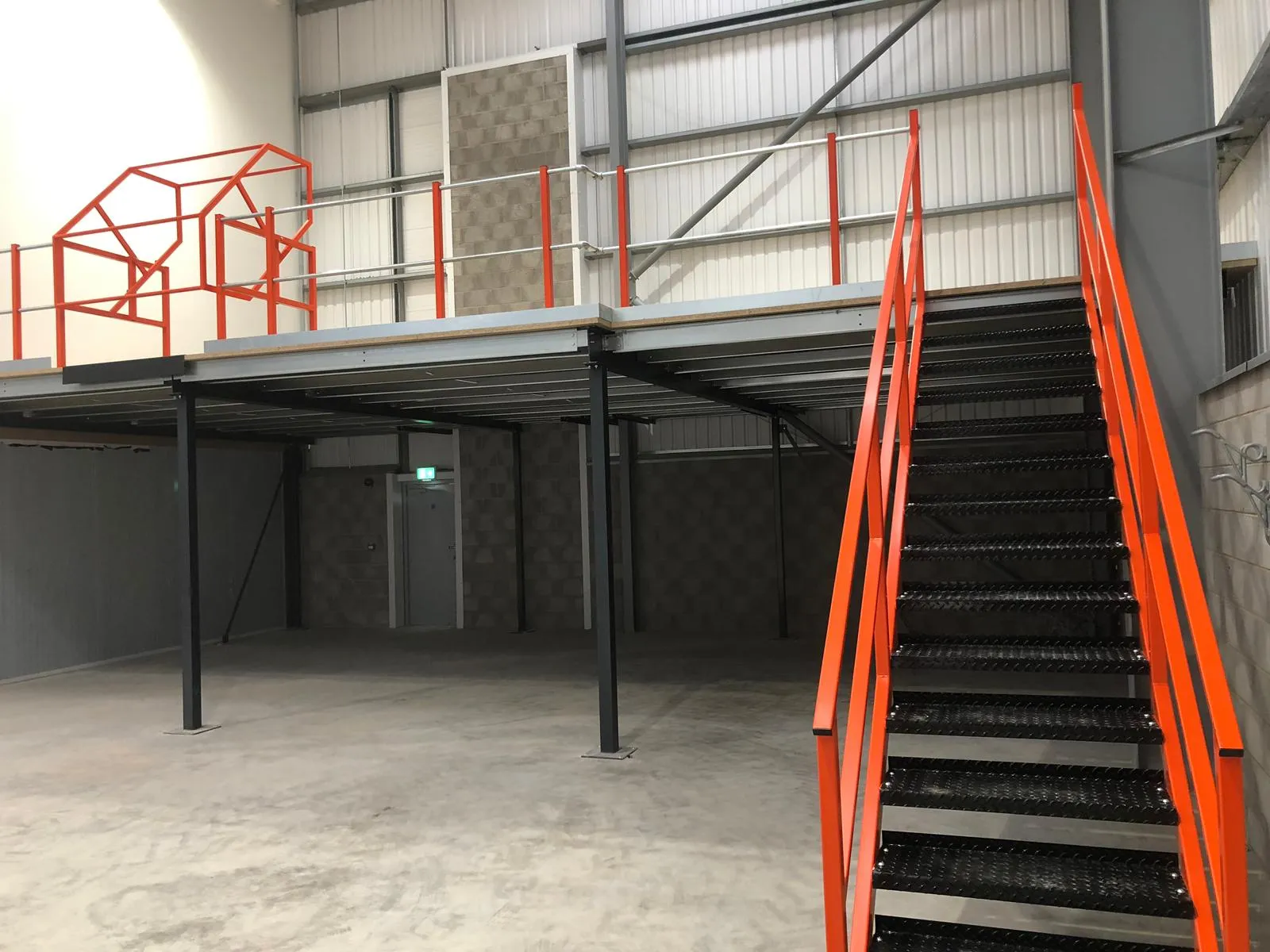Adding a mezzanine floor to your building is an excellent way to expand your space without the cost and disruption of a full-blown addition. However, ensuring your new mezzanine is safe and meets building codes requires careful planning, especially concerning load capacity. This guide will walk you through everything you need to know about mezzanine floor loading guidelines to help you design and build a safe and compliant structure.
Mezzanine Floor Loading Guidelines: Making Sure Your Mezzanine is Safe and Sound
Mezzanine floor loading guidelines are crucial for ensuring your structure is safe and can support the intended weight. These guidelines, established by organizations like OSHA (Occupational Safety & Health Administration) and the IBC (International Building Code), act as the rulebook for mezzanine construction, covering aspects like load calculations, material choices, and structural analysis.
Headroom and Safety First!
Before considering load capacity, prioritize safety and comfortable movement within the mezzanine space:
- Headroom: Ensure a minimum clearance of 7 feet above and below the mezzanine to prevent head injuries.
- Stairways and Guardrails: Design and construct stairways and guardrails according to specific safety standards to prevent falls. For more information on what the legal mezzanine legal height is, click here. To learn more about proper mezzanine floor headroom clearance, click here. To ensure that your mezzanine structure safety standards are met, click here.
Load Capacity: What Can Your Mezzanine Actually Hold?
Every mezzanine has a defined load capacity, representing the maximum weight it can safely support. This capacity encompasses two types of weight:
- Dead Load: The weight of the mezzanine structure itself, including beams, columns, decking, and all other fixed components.
- Live Load: The weight of everything placed on the mezzanine, including people, furniture, equipment, and stored goods.
Understanding the difference between these loads is crucial for accurate load capacity calculations.
Load Capacity Variations:
Load capacity requirements differ based on the intended use of the mezzanine:
- Light-duty mezzanines commonly found in residential settings or for light storage typically have a uniform load capacity of 125 pounds per square foot.
- Commercial mezzanines designed for offices require a live load capacity of at least 50 pounds per square foot to accommodate people, desks, and other office equipment.
- Storage mezzanines need to handle heavier loads, with typical requirements starting at 125 pounds per square foot to support stored goods effectively.
Crunching the Numbers: Calculating Your Load Requirements
Determining the exact load capacity for your mezzanine involves considering its intended use and how the weight will be distributed:
- Intended Use: The planned activities on the mezzanine significantly impact the load calculations. For instance, a mezzanine intended for heavy machinery storage will require a much higher load capacity than one designed for additional office space.
- Weight Distribution:
- Uniform Load: Weight distributed evenly across the entire mezzanine floor, such as boxes stacked uniformly.
- Concentrated Load: Weight concentrated in a specific area, such as heavy machinery. Concentrated loads necessitate additional structural reinforcement to prevent structural issues.
Safety Features That Matter
Integrating safety features beyond headroom and proper stair design is essential to ensure a secure mezzanine environment:
- Handrails and Guardrails: Essential for preventing falls from the mezzanine’s edges and must comply with safety regulations.
- Fall Protection Systems: Depending on the mezzanine’s height and intended use, additional fall protection systems, such as anchorage points for safety harnesses, may be required.
Beyond the Basics: Extra Things to Keep in Mind
Along with load capacity and safety, address these factors for optimal mezzanine design:
- Ergonomics: Design the mezzanine with user comfort in mind, considering platform height, handrail placement, and adequate lighting.
- Sustainability: Explore using recycled or sustainable materials during construction to minimize the environmental impact.
- Cost Optimization: Maximize space utilization and find cost-effective solutions without compromising safety or code compliance.
What are the OSHA Requirements for Mezzanine Floor Loading Guidelines?
OSHA regulations play a critical role in ensuring the safety of workers on and around mezzanines. These regulations focus on fall protection, structural integrity, and clear communication of load limits.
OSHA Requirements: Keeping Things Safe Upstairs
- Fall Protection is Key: OSHA mandates the installation of guardrails and gates on mezzanines to prevent falls, acting as safety barriers to prevent accidental falls from the elevated platform.
- Solid Construction is a Must: The IBC (International Building Code) provides specific guidelines on designing and constructing structurally sound mezzanines. Adhering to these guidelines ensures the mezzanine can handle the intended loads without compromising structural integrity.
- Know Your Limits: Clearly display the weight limit of the mezzanine with prominently posted signs, as required by OSHA. This practice prevents overloading the structure and potential collapse.
- Check with Your Local Authorities: In addition to federal regulations, consult with local building departments to ensure compliance with any additional local codes or requirements.
Understanding IBC Mezzanine Floor Loading Guidelines
The IBC provides comprehensive guidelines for mezzanine construction, focusing on safety and structural integrity. These guidelines cover various aspects, including height restrictions, area limitations, open layout requirements, and means of egress.
Key IBC Mezzanine Requirements:
- Clear Height: Maintaining a minimum clear height, typically 7 feet, both above and below the mezzanine is crucial for safe movement and to avoid head injuries.
- Area Limitations: The IBC typically limits the maximum area of a mezzanine to one-third of the floor area of the room below. This limitation ensures adequate open space and prevents overloading the existing structure.
- Open Layout: Mezzanines should generally maintain an open layout to the room below, except for walls less than 42 inches high. This design facilitates natural light and ventilation while providing a sense of openness.
- Means of Egress: IBC guidelines mandate that mezzanines comply with Chapter 10 building codes, which address means of egress or safe and accessible evacuation routes in case of emergencies.
Load Capacity Variations: IBC Considerations
IBC parameters also influence mezzanine load capacity requirements. While live load capacities typically range from 125 to 250 pounds per square foot, the specific requirements depend on the intended use and design of the mezzanine. Factors like the type of materials used, the spacing of support beams, and the overall structural design all contribute to determining the appropriate load capacity.
How to Calculate Mezzanine Floor Load Capacity Accurately
Accurately calculating the load capacity of your mezzanine floor is vital to ensure its safety and prevent structural issues.
Using a Mezzanine Load Capacity Calculator:
For a simplified approach, utilize a Mezzanine Load Capacity Calculator. These online tools typically require inputting the floor area, desired floor load, and mezzanine type to provide an estimated maximum weight capacity.
Manual Calculation:
If you prefer a hands-on approach, you can calculate load capacity manually using the following formula:
Load Capacity = Floor Area * Floor Load
- Measure Your Space: Measure the length and width of your mezzanine floor and multiply those numbers to calculate the total area in square feet.
- Determine Your Floor Load: Based on the intended use, determine the required floor load. This value represents the weight the floor needs to support per square foot. Consider both dead and live loads when determining the appropriate floor load.
- Choose the Right Mezzanine Type: Select a mezzanine type with a load capacity that meets or exceeds your calculated requirements.
- Calculate Load Capacity: Multiply the floor area by the determined floor load to calculate the maximum weight capacity.
Weight Distribution:
Proper weight distribution is essential to prevent overloading specific areas of the mezzanine. Ensure the weight is spread evenly across the entire floor, considering both dead and live loads. Avoid concentrating heavy items in one spot, as this can lead to structural stress and potential failure.
Conclusion
Designing and constructing a safe and compliant mezzanine requires careful consideration of various factors, especially load capacity. Adhering to OSHA requirements, IBC guidelines, and understanding the importance of accurate load calculations are crucial steps in this process. By prioritizing safety, understanding your specific load requirements, and following the outlined guidelines, you can create a functional and secure mezzanine space that seamlessly integrates with your existing building.
- Marble Countertops Cost: What Factors Impact the Total Price? - January 2, 2026
- Small Corner Kitchen Ideas: Maximize Style In Tight Spaces - January 1, 2026
- Kitchen Counter Corner Ideas: Style Your Awkward Angles Now - December 31, 2025










